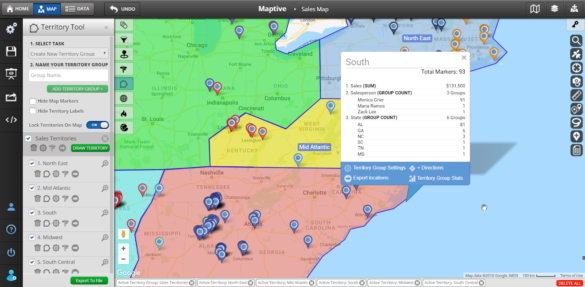
An effective sales territory plan improves the efficiency and performance of your entire team. Assigning territories to each of your reps makes dividing up accounts easy, ensuring everyone has an equal opportunity to make a sale. With this strategy, customers always deal with the same rep, resulting in better customer relationship management.
Today’s businesses have access to software that makes building a sales territory plan is easier than ever. Tools like Maptive plot all your customers on an interactive map, greatly simplifying the process of creating effective territories.
Are you thinking about creating a sales territory plan for your business? Does your current plan need to be adjusted?
Keep reading to learn how sales territory planning works and how to do it effectively.
Table of Contents
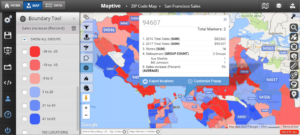
Sales territory planning is the process of dividing your service area into different geographic regions that can be assigned to dedicated sales representatives.
Once a person is assigned a territory, they are responsible for any existing accounts in that region and new customers within those boundaries. They also generate leads and prospects in the area to bring in new business.
Creating a good sales territory plan streamlines the sales process. The obvious benefit is that sales and accounts are divided fairly, leading to a more equitable workplace.
While this is important, it’s far from the only benefit. Here are a few other reasons why sales territory planning is critical for your business:
Salespeople want the opportunity to succeed and grow within their roles, but this can’t happen when a few team members are taking all the sales for themselves. If your staff feel like they aren’t given a chance to reach their full potential, they may start looking elsewhere for employment.
This could result in you losing talented people to your competitors simply because you don’t have a proper sales territory plan. Hiring and onboarding new sales reps is also costly, so you want to reduce turnover as much as possible.
By creating sales territories, you make sure that everyone has a chance to achieve their goals. This means a higher employee retention rate and a positive reputation for your business.
Have you ever dealt with a company that makes you talk to a different person each time you call? Every time you speak to someone, you have to repeat the same information about your business and your problems before they can help you.
By having a dedicated rep for each territory, your customers will always deal with the same person. In addition, sales reps will get to know their customers’ businesses and offer more personalized solutions to address their needs.
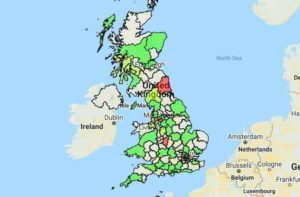
Once your territories are in place, you’ll have access to a wide range of data, including sales, customers, revenue, and more. This makes it easy to compare one region to another to see where you’re performing well and where you have room for improvement.
Say one of your territories is underperforming. Without any data, it isn’t easy to know why. Is the sales rep assigned to that area not meeting expectations? Or are your products and services just not resonating with the demographics located there? Digging into the data can help you solve these problems.
Conversely, you can look at sales territories that are outperforming other regions to gather important insights. For example, what is the sales rep in the area doing differently? Can the tactics being used there be applied to other territories to increase sales?
Answering these types of questions can help you take your business to the next level.
Sales territory planning isn’t over once your territories are established. Remember, as your business grows, your sales territory plan needs to grow along with it.
For example, what happens if one of your reps lands an exceptionally large account? While this is great for both them and the business, it presents a problem for the other customers in their territory. Suddenly, the rep doesn’t have as much time to follow up on leads and service other customers.
As your customer distribution changes, your territories will need to be adjusted. And as your customer base grows, you’ll eventually need to divide up existing territories and hire new staff.
One of the biggest expenses associated with outbound sales is travel costs. The further your reps have to travel, the more it’s going to cost you, so it makes sense for you to reduce driving time as much as possible.
By assigning your sales reps to customers that are located nearby, you’ll ensure they never have to travel too far to get to their next sales meeting. This means less fuel consumption and fewer repairs to their vehicles.
It also means they can meet with more customers in a single day, which will lead to added sales for your business.
It’s clear that established sales territories can benefit your business in a number of ways. But what goes into actually creating them? Here are three factors you should consider:
Are you ready to create your sales territories? Don’t rush into it. To do it right, there are several steps you should take.
The best sales territory plans are built with extensive research and reliable data. The last thing you want is to spend a large amount of time drawing your territories only to have to redo the process a few months down the road.
When creating your territories, there are six steps you need to follow:
Before you begin your plan, you should figure out what exactly you’re looking to achieve. Then, once you establish your long-term goals, you can build your territories with them in mind.
Here are some questions you need to ask yourself:
After answering these questions, you should have a clearer picture of how your territories need to be drawn.
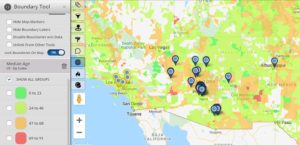
Next, you’ll want to analyze your past performance to see if any trends should be considered when creating your territories.
Most importantly, you need to understand your customers. To do this, answer the following questions:
Get to the bottom of these questions to predict where your sales are most likely to come from. This will make it easier to create sales territories that are more evenly balanced.
Your total addressable market (TAM) is the maximum amount of money you can make selling your products and services. Essentially, it’s a way to measure the level of demand for what you’re selling.
While it’s important to base your territories on your current customers, you also need to plan for the future. Figuring out your TAM will help you identify potential opportunities that are available to your business and new regions or segments of the population that need to be a part of your plan.
There are three ways to calculate your TAM:
None of these methods are perfect, so it’s best to use a combination of all of them and base your conclusions on that. Make sure to consider these results when planning your territories.
Up to this point, we’ve been mainly focusing on your customer base. Now it’s time to analyze your business to see what you’re good at, what you need to improve, and what external factors could impact you.
The best way to do this is to perform a SWOT analysis. This stands for strengths, weaknesses, opportunities, and threats. A solid understanding of all of these is key to developing a winning sales territory plan.
Work your way through each area of the analysis to uncover important information about your business.
Once your SWOT analysis is complete, you’ll know what areas of your market and business need attention, making it easier to create a successful sales territory plan.
Assigning the right sales reps to the right territories will play a big part in your plan’s success.
Your more experienced and skilled salespeople will be able to manage a higher number of accounts at once and will be better at handling more complex deals. On the other hand, new reps need to be eased in and given a lighter workload as they grow their skills.
So, while it may seem unfair at first, assigning larger territories to some reps and smaller ones to others makes sense. In reality, you’re helping your less experienced team members by not overloading them too quickly.
As your reps prove they can handle more responsibility, adjust your sales territory plan to accommodate the changing dynamics of your team.
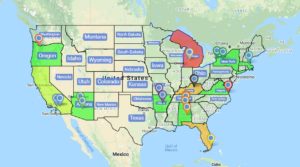
No plan will be perfect right from the start. Ensure your sales territories are successful by continually analyzing and optimizing them.
Don’t be discouraged if you don’t achieve the results you expected straight away. Chances are, you need to make minor adjustments to get back on track. This is part of effective sales territory management.
While tracking and analyzing your results, make sure to consider the following:
Be sure to review your plan often and make changes as needed. If you stay on top of it, you should begin to see your performance improve.
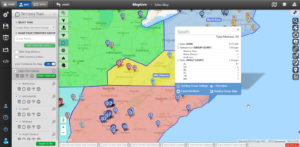
Mapping software like Maptive makes visualizing your sales territories easy.
Start by plotting all of your customers and accounts, then create your territories as you see fit. Use established boundaries like zip codes, cities, counties, and states, or draw custom territories to suit your needs.
Gain additional insights by adding data such as leads, sales, and revenue to measure the performance of each territory. Use demographic insights to analyze your customer base in each region and determine the best targeting methods.
Customize your sales territory map further by adding heat maps, radii, and optimized routes to give your sales reps the best chance at success.
Does your business need a detailed sales territory plan? Then, sign up for a Maptive free trial account and start mapping your territories.
Brad Crisp is the CEO at Maptive.com, based in Denver, CO and born in San Francisco, CA. He has extensive experience in Business Mapping, GIS, Data Visualization, Mapping Data Analytics and all forms of software development. His career includes Software Development and Venture Capital dating back to 1998 at businesses like Maptive, GlobalMojo (now Giving Assistant), KPG Ventures, Loopnet, NextCard, and Banking.
